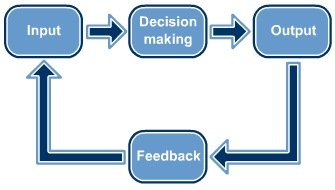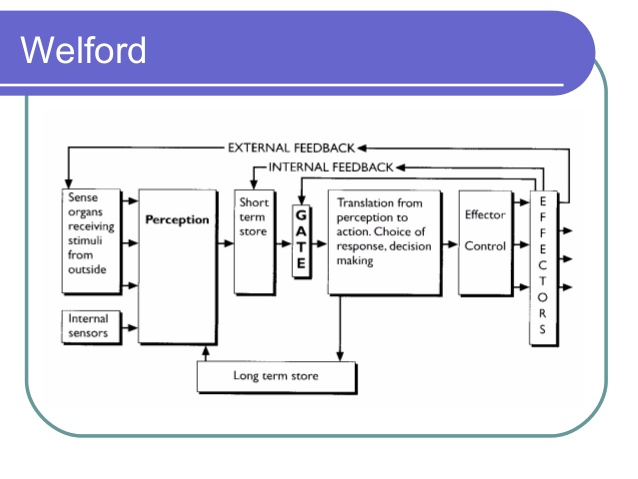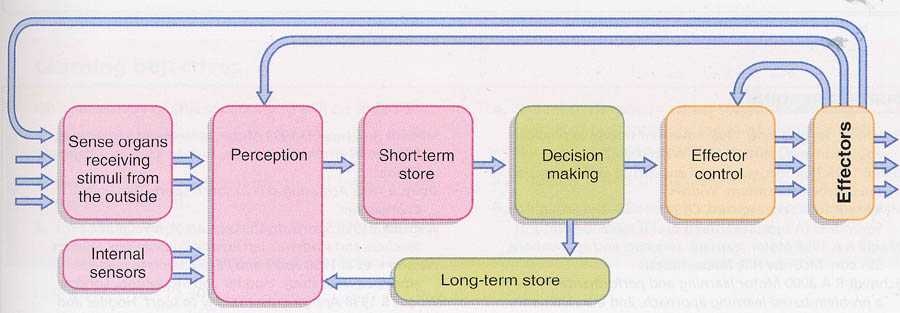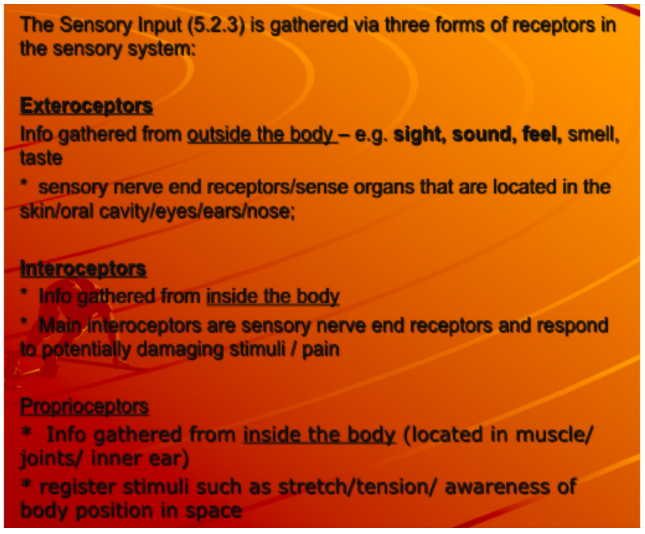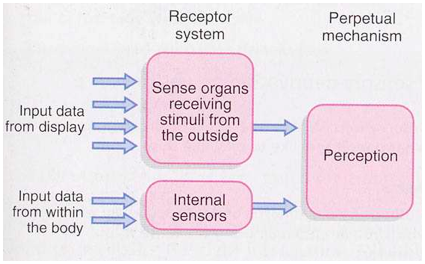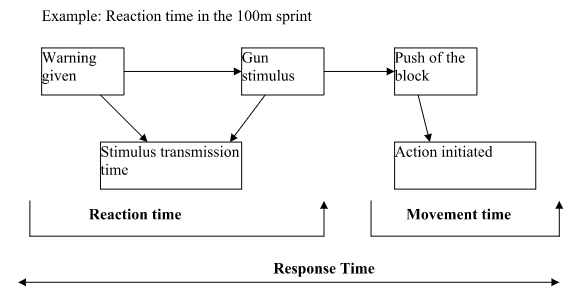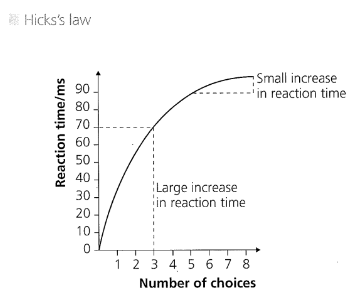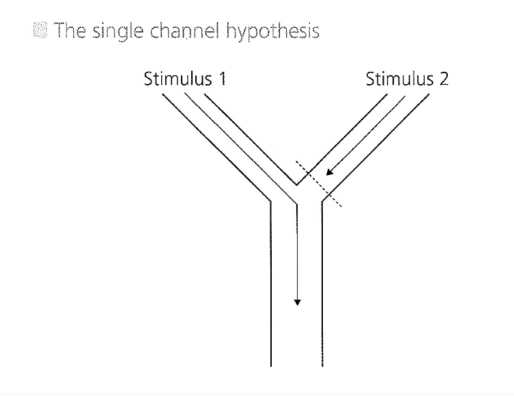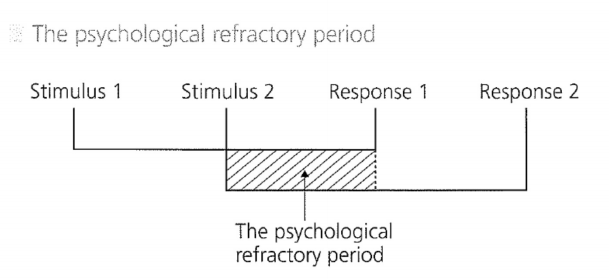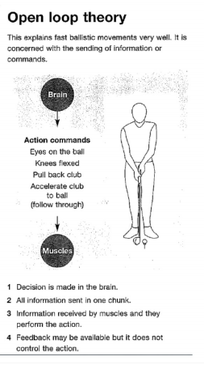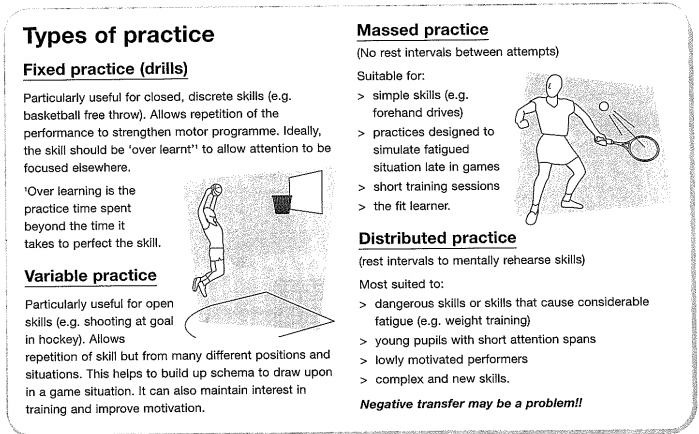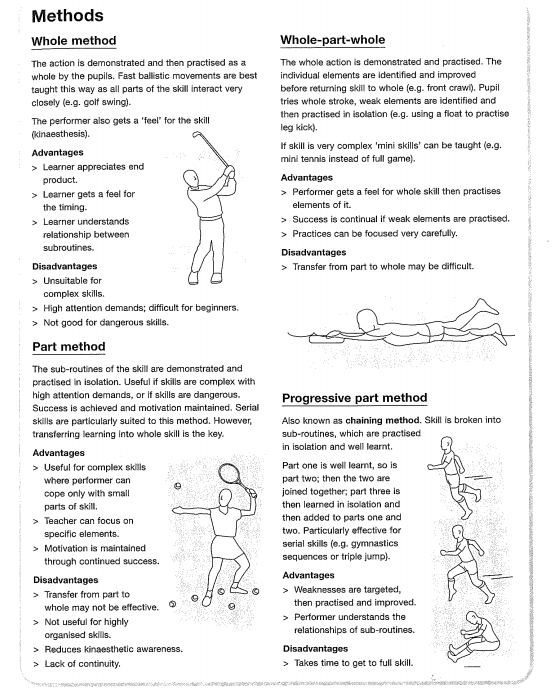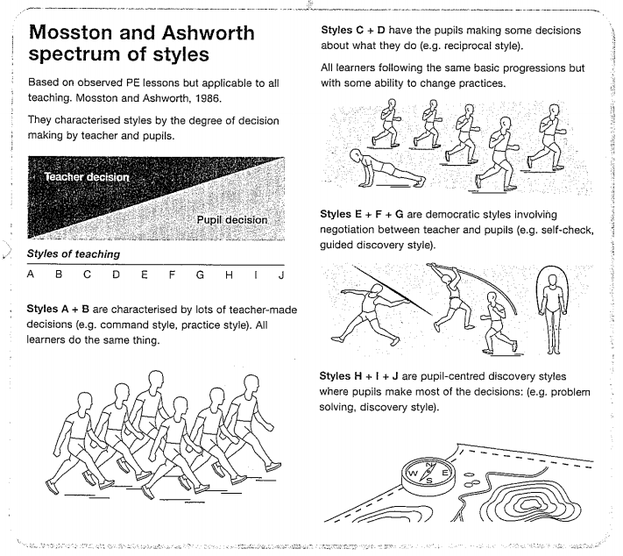5.1 The characteristics and classification of skill
5.1.1 Give a definition of Skill
The consistent production of goal-oriented movements, which are learned and specific to the task.
5.1.2 Describe the different types of skill
cognitive: Ability to solve problems by thinking
perceptual: Process by which you sense things and interpret them
motor: A voluntary body movement with a predetermined end result
perceptual-motor: Involve the thought, interpretation and movement skills
cognitive: Ability to solve problems by thinking
perceptual: Process by which you sense things and interpret them
motor: A voluntary body movement with a predetermined end result
perceptual-motor: Involve the thought, interpretation and movement skills
5.1.3 Outline the different approaches to classifying motor skills
- Gross - Fine
- Open - Closed
- Discrete - Serial - Continuous
- Externally paced - Internally paced
- Individual - Coactive - Interactive
5.1.4 Compare skills profiles for contrasting sports
Gross - Fine
Open - Closed
Discrete - Serial - Continuous
Externally paced - Internally paced
Individual - Coactive - Interactive
Gross - Fine
- Gross: large movements using large muscles or involving whole muscle groups; movements such as rolling over, kicking, flipping
- Fine: small and intricate movements, using small muscles often at the extremities; such as fingers, toes, wrists and tongues
Open - Closed
- Open: a skill performed in an unstable environment, where the environmental stimuli determines the initiation of the movement
- Closed: performed in a stationary environment, and it highly controlled by the individual, who dictates the initiation. Often easier.
Discrete - Serial - Continuous
- Discrete: brief and defined actions that have a definitive start and end to their movement. Single, specific actions; such as a penalty kick
- Serial: a sequence of discrete skills joined together to create a greater movement, such as a triple jump
- Continuous: has no obvious beginning or end, actions are repeated in a cyclical form, such as running, can be stopped throughout the performance
Externally paced - Internally paced
- Externally paced: the environment (including opponents) control the pace at which the skill is executed, these factors will affect the performance and must be taken into account by the performer. Typically open skills.
- Internally paced: performer dictates the rate of speed that the skills are performed, often comprise of closed skills (javelin throw)
Individual - Coactive - Interactive
- Individual: skills performed in isolation, like a high jump
- Coactive: skills that may be performed in unison with other competitors, but do not involve direct confrontation or contact, eg. swimming
- Interactive: skills performed where others are directly involved, such as game sports like rugby or football
5.1.5 Outline ability
Ability refers to a general train or capacity of the individual that is related to the performance and performance potential of a variety of skills or tasks
Perceptual Abilities
Way in which we notice significant things that are happening around us and how quickly and effectively we make decisions about how to deal with them.
For example it is the way in which:
1. You make sense of the information you receive from the environment ie. to perceive it, interpret it and identify elements in it which are important, for eg. whether the ball is spinning or not, what the flight path of the shuttle is, whether there is a gap in the defence which can be exploited.
2. Recognition and interpretation relies on previous experience and memory of that experience.
3. Decision making decide what to do - muscles then need to carry out the required movement.
Motor abilities (movement and performance)
Personal characteristics or enduring traits which, affect an individuals output
Perceptual-motor or Psychomotor abilities - a combination of perceptual and motor abilities
Capability to process, interpret and use sensory stimuli for performing a task .
Ability refers to a general train or capacity of the individual that is related to the performance and performance potential of a variety of skills or tasks
Perceptual Abilities
Way in which we notice significant things that are happening around us and how quickly and effectively we make decisions about how to deal with them.
For example it is the way in which:
1. You make sense of the information you receive from the environment ie. to perceive it, interpret it and identify elements in it which are important, for eg. whether the ball is spinning or not, what the flight path of the shuttle is, whether there is a gap in the defence which can be exploited.
2. Recognition and interpretation relies on previous experience and memory of that experience.
3. Decision making decide what to do - muscles then need to carry out the required movement.
Motor abilities (movement and performance)
Personal characteristics or enduring traits which, affect an individuals output
Perceptual-motor or Psychomotor abilities - a combination of perceptual and motor abilities
Capability to process, interpret and use sensory stimuli for performing a task .
5.1.6 Distinguish between Fleishman's physical proficiency abilities (physical factors) and perceptual motor abilities (psychomotor factors)
Fleishman’s Physical Proficiency (Gross Motor)Abilities - Health related
· Extent flexibility
· Dynamic flexibility
· Explosive strength
· Static strength
· Dynamic strength
· Trunk strength
· Gross body co-ordination
· Gross body equilibrium
· Stamina
Fleishman’s Perceptual Motor (psychomotor) Abilities - Skill related
Fleishman’s Physical Proficiency (Gross Motor)Abilities - Health related
· Extent flexibility
· Dynamic flexibility
· Explosive strength
· Static strength
· Dynamic strength
· Trunk strength
· Gross body co-ordination
· Gross body equilibrium
· Stamina
Fleishman’s Perceptual Motor (psychomotor) Abilities - Skill related
- Reaction time
- Response orientation
- Speed of movement
- Finger dexterity
- Manual dexterity
- Response integration
5.1.7 Define the term technique
Technique in general terms is a "way of doing". In the performance of a specific sports skill it is defined as the "the way in which that sports skill is performed".
Technique in general terms is a "way of doing". In the performance of a specific sports skill it is defined as the "the way in which that sports skill is performed".
5.1.8 State the relationship between ability, skill and technique
Skill = ability + technique
Skill = ability + technique
5.1.9 Discuss the relationship between a skilled and a novice performer
consistency
consistency
- Skilled: would be very consistent as they are an expert (autonomous) in their sport
- Novice: would have many errors and not yet be consistent as they are still in the learning (cognitive or associative) stage
- Skilled: more likely to be accurate, for same reasons as above
- Novice: less accurate in their performance as they are less consistent and skilled
- Skilled: will have more control in their movements as they have stored muscle memory from completing the action so many times
- Novice: will have less control, comes with lack of consistency and accuracy, as they have not had great time for practice
- Skilled: they will be knowledgable on their sport and technique
- Novice: may need assistance in understanding correct technique
- Skilled: will be able to achieve desired goal much quicker than a novice player
- Novice: will take a long time to reach desired goal
- Skilled: will know exactly what they want to produce and what steps are needed to get there
- Novice: may know what they want to achieve but not the steps to get there
- Skilled: difficult skills will look effortless and smooth
- Novice: will look erratic and uncontrolled
5.2 Information Processing
5.2.1 Describe a simple model of information processing
|
In response to input stimuli, the performer perceives the stimulus, and recounts by executing an appropriate output, after their brain goes through the decision making process. Feedback is then often given, so that the response can be altered to be made better if necessary.
Example: A penalty kick is about to take place, the goalie observes the angle of the kicker (input), makes a decision on where to dive (decision making) and follows with a diving movement (output). Terminal feedback on the movement is applied for the next shot. |
5.2.2 Describe Welford's model of information processing
5.2.3 Outline the components associated with sensory output
|
The information is taken in through the senses prior to a decision being made in three main ways. These are:
Touch – is our tactile sense, it detects pressure, pain, temperature. It's used in many sports. Eg The feel of the ball in the hands or the tense feel of the tennis racket in the hand as you hit a return |
Exteroceptors: Exteroceptors provide information about the external environment, like touch, pressure, temperature, light, sound, taste, smell etc. Sometimes receptors sensing light, sound and smell, which provide information about the distant environment, have been called telereceptors.
Introceptors: Pass information from within the body’s internal organs such as the heart and lungs to the brain via the nervous system. This helps to regulate the various functions of the body and cater for the changing demands placed upon it. Kinaesthetic information or Proprioception (body awareness) - the inner sense within the muscles, tendons and joints, which gives automatic internal information about the position of joints and the tension in the muscles. Proprioceptors: Proprioceptors provide information about the position and posture of our body in space. They sense stimuli from the muscles, tendons and the joints as well from the vestibular apparatus. Equilibrium – the balance needed before hitting a serve or the balance used in the skillful performance of a gymnast on the balance beam.
Kinaesthesis - the inner sense within the muscles, tendons and joints, which gives automatic internal information about the position of joints and the tension in the muscles. A javelin thrower would know, without looking, that the arm is fully extended and that the elbow is ‘locked’ before he throws. |
5.2.4 Explain the signal-detection process
Brain identifies that a stimulus is present. It often detects more stimuli than we are aware of. If we attend to that information even briefly, then it is passed further through the process
Perception is the process by which the brain interprets and makes sense of the information it is receiving from the sensory organs
Sporting example: Returning a tennis serve
Detection: the ball is tossed above the head rather than slightly in front, stimulus ranges from spin and flight path of the ball. These important stimuli stand out from background noise of irrelevant detail through selective attention
Comparison: the stimulus is passed through the memory and compared with similar codes stored in the memory such as a previous serve from the same opponent in the match
Recognition: occurs when the code of incoming information matches a code stored in the long term memory. Early signal detection detects the type of service before the action takes place. Utilizing selective attention and using past experiences improves signal detection.
Brain identifies that a stimulus is present. It often detects more stimuli than we are aware of. If we attend to that information even briefly, then it is passed further through the process
Perception is the process by which the brain interprets and makes sense of the information it is receiving from the sensory organs
- Detection: identification of the stimulus
- Comparison: gathered stimuli compared to memory stores
- Recognition: the stimuli is matched to one stored in the memory
Sporting example: Returning a tennis serve
Detection: the ball is tossed above the head rather than slightly in front, stimulus ranges from spin and flight path of the ball. These important stimuli stand out from background noise of irrelevant detail through selective attention
Comparison: the stimulus is passed through the memory and compared with similar codes stored in the memory such as a previous serve from the same opponent in the match
Recognition: occurs when the code of incoming information matches a code stored in the long term memory. Early signal detection detects the type of service before the action takes place. Utilizing selective attention and using past experiences improves signal detection.
5.2.5 Distinguish between the characteristics of short-term sensory store, short-term memory and long-term memory
Distinguish between short-term sensory store and short-term memory (3) |
Short term sensory store, or sensory information store is the brain picking up on visual stimuli in tenths of seconds. The brain can pick up and understand the complete image in a quarter of a second and has an unlimited capacity of understanding sensory stimulation. Short term memory however, has a duration of seconds to minutes, but has a limited capacity of only 5-7 pieces of information that can be comprehended in the short term store. When retrieving from your short term memory, before information is transferred into the long term memory, the brain only receives direct access to interpretations of the information.
|
5.2.6 Discuss the relationship between selective attention and memory
and explain how it can be applied to a games player
Memory can be described as “the capacity that permits organisms to benefit from their past experiences” (Tulving 1985). It is the skill of storing all previous occurrences in the long term memory of the brain where retrieval is permitted in future experiences. Selective attention however, is the type of memory where you can only focus on one thing (no multitasking) (Welford 1968) or on two things that require different area of the brain (Wickens 1980). Memory and selective attention play a role in the competitive play of sport, where performers must recall and retrieve knowledge from the long-term store of their memory, but utilize the skill of selective attention in order to only recall the memories vital for the skill and performance being done in the moment. Selective memory is used not only in sport, but in all parts of life as a human can not possibly pay attention to everything in a ocean of irrelevance and unimportance. In a touch game when performing an attacking line move for example, you may remember all of the training you have done on the skill and other variations of the move, but with the aid of selective attention, you recall and only think about where you have to go, in the position you are in and the situation you are in.
and explain how it can be applied to a games player
Memory can be described as “the capacity that permits organisms to benefit from their past experiences” (Tulving 1985). It is the skill of storing all previous occurrences in the long term memory of the brain where retrieval is permitted in future experiences. Selective attention however, is the type of memory where you can only focus on one thing (no multitasking) (Welford 1968) or on two things that require different area of the brain (Wickens 1980). Memory and selective attention play a role in the competitive play of sport, where performers must recall and retrieve knowledge from the long-term store of their memory, but utilize the skill of selective attention in order to only recall the memories vital for the skill and performance being done in the moment. Selective memory is used not only in sport, but in all parts of life as a human can not possibly pay attention to everything in a ocean of irrelevance and unimportance. In a touch game when performing an attacking line move for example, you may remember all of the training you have done on the skill and other variations of the move, but with the aid of selective attention, you recall and only think about where you have to go, in the position you are in and the situation you are in.
5.2.7 Compare different methods of memory improvement
Rehearsal: required to get information into LTM, and to increase the chances of being able to recall that information.
coding: information associated with images can be recalled better with the associations
brevity: it is easier to remember short and specific details rather than long and vague information
clarity: if the information is clear and understood, it will be easier to remember
chunking: To some degree we do this automatically. It is literally a case of chunking several pieces of information into one meaningful chunk, which takes up less space in STM
organization: if the information is in a clear and logical format it makes it easier for recall
association: semantic understanding increases recall
practice: same with rehearsal
Rehearsal: required to get information into LTM, and to increase the chances of being able to recall that information.
coding: information associated with images can be recalled better with the associations
brevity: it is easier to remember short and specific details rather than long and vague information
clarity: if the information is clear and understood, it will be easier to remember
chunking: To some degree we do this automatically. It is literally a case of chunking several pieces of information into one meaningful chunk, which takes up less space in STM
organization: if the information is in a clear and logical format it makes it easier for recall
association: semantic understanding increases recall
practice: same with rehearsal
5.2.8 Define the term response time
Response time = reaction time + movement time
In sprinting:
Reaction time: is the amount of time between a stimulus and the first movement initiated response to it. Does not include movement time. Eg. hearing the gun to pushing against the blocks.
Movement time: is the time taken to complete the task after it has been initiated. Begins when the body begins to move - not when then stimulus is applied - and ends when the task is completed. Eg. pushing against the blocks to hitting the tape.
Response time: total time from the presentation of stimulus to the completion of the task. Eg. hearing the gun to hitting the tape.
Response time = reaction time + movement time
In sprinting:
Reaction time: is the amount of time between a stimulus and the first movement initiated response to it. Does not include movement time. Eg. hearing the gun to pushing against the blocks.
Movement time: is the time taken to complete the task after it has been initiated. Begins when the body begins to move - not when then stimulus is applied - and ends when the task is completed. Eg. pushing against the blocks to hitting the tape.
Response time: total time from the presentation of stimulus to the completion of the task. Eg. hearing the gun to hitting the tape.
|
5.2.9 Outline factors that determine response time
Group variance - gender + age Reaction time includes stimulus transmission, detection, recognition decision to respond, nerve transmission time and initiation of action. How to improve response time: Anticipation – reduce the time they take to respond to a stimulus Attention to preliminary movement Develop good signal detection (DCR process): cue and relevant cues Decision making Change in attention focus – selective attention Control anxiety Creating optimum levels of motivation Practice at a quicker pace Warm up Mental rehearsal – visually in mind |
5.2.10 Evaluate the concept of the psychological refractory period (PRP)
5.2.11 Describe a motor programme
A set of movements stored as a whole in the memory regardless of whether feedback is available or not
A motor program is a set of movements that that is stored in the memory and can be reproduced to create movements. Motor programs contain subroutines, which breakdown the actions required in a sport. For example in touch, the action of doing an A-Drive, can be broken down into subroutines, consisting of taking the touch, placing the ball, stepping over the ball, and then picking up. As the skill level of the performer increases, and the proficiency of the athlete does as well, the routines then become subroutines, as they begin to make up more complex skills within the sport. An example of this would be the A-Drive being then incorporated into a 42, where a backdoor component is added.
A set of movements stored as a whole in the memory regardless of whether feedback is available or not
A motor program is a set of movements that that is stored in the memory and can be reproduced to create movements. Motor programs contain subroutines, which breakdown the actions required in a sport. For example in touch, the action of doing an A-Drive, can be broken down into subroutines, consisting of taking the touch, placing the ball, stepping over the ball, and then picking up. As the skill level of the performer increases, and the proficiency of the athlete does as well, the routines then become subroutines, as they begin to make up more complex skills within the sport. An example of this would be the A-Drive being then incorporated into a 42, where a backdoor component is added.
- a whole plan (executive program/ motor program)
- subroutines
- coordination of subroutines
- relegating executive programmes to subroutines
5.2.12 Compare motor programmes from both open and closed loop perspectives
|
Open Loop Theory
This theory states the following:
Closed Loop Theory On the other hand, this theory explains slow movements well but not fast movements.
Closed loop theory only works when the skill is done enough times by the performer, so that their muscle memory of the skill can be stored in the memory trace. When the performer detects an error, they use the perceptual trace, which is an immediate detection of the movement stored in the short term memory, and compare it to their memory trace. The differences between the two are then augmented and the perceptual trace is changed to match the memory trace and improve performance. |
5.2.13 Outline the role of feedback in information processing models
intrinsic (self given) and extrinsic (given by others eg. coach)
knowledge of results (was there a goal or was it a miss) and knowledge of performance (correct technique, improper technique)
positive (encouragement) and negative (un-constructive)
concurrent (during the task itself) and terminal (after task completion)
intrinsic (self given) and extrinsic (given by others eg. coach)
knowledge of results (was there a goal or was it a miss) and knowledge of performance (correct technique, improper technique)
positive (encouragement) and negative (un-constructive)
concurrent (during the task itself) and terminal (after task completion)
5.2.14 Outline the role of feedback with the learning process
reinforcement of learning
motivation
adaptation of performance
punishment
reinforcement of learning
motivation
adaptation of performance
punishment
5.3 Principles of skill learning
5.3.1 Distinguish between learning and performance
Learning is a relatively permanent change in performance brought about by experience, excluding changes due to maturation and degeneration.
Performance is a temporary occurrence, fluctuating over time.
A change in performance over time is often used to infer learning.
Learning is a relatively permanent change in performance brought about by experience, excluding changes due to maturation and degeneration.
Performance is a temporary occurrence, fluctuating over time.
A change in performance over time is often used to infer learning.
5.3.2 Describe the phases (stages) of learning
|
The cognitive stage of learning is the first stage in learning a new sport. Within the cognitive stage of learning, athletes are often young or new to the sport. A coach teaches primarily through demonstrating and visual learning, effecting the concept of Bandura's Social Learning Theory. By watching skills, the athletes in the cognitive stage of learning then practice. They learn by trial and error at this stage and are expected to make many errors. In order to combat these and teach the performers, there is a large emphasis on feedback from the coach.The feedback must be extrinsic as the performers do not have the knowledge or muscle memory to know if the skill is done correctly. In this stage, the feedback is primarily knowledge of results. After the performer succeeds more frequently, they will move into the associative stage of learning.
|
5.3.3 Outline the different types of learning curves
Positive Acceleration Plateau
Linear Negative Acceleration
Linear Negative Acceleration
5.3.4 Discuss factors that contribute to the different rates of learning
Physical maturation
physical fitness
individual differences of:
Physical maturation
physical fitness
individual differences of:
- coaching
- age
- difficulty of task
- teaching environment
- motivation
Discuss factors that may contribute to the different rates of learning between two divers. |
One diver might learn much quicker than the other due to a higher level of fitness, for instance, one might have greater leg power, which aids the anaerobic acceleration off the diving board and allows the dive to be more explosive. Similarly, one of the divers might have higher flexibility, which increases the level of difficulty of skills and execution that the diver is able to perform at. Motivation, is also vital in the rate of learning, one diver may not be as interested or ready to learn new skills, which will hinder their rate of learning and improvement. Also, physical maturation, which is linked to motivation, is the ability to know when you are reader to learn new skills. This comes with age and practice, two other things that could increase the rate of learning for one diver. Typically as you get older, the more muscular you are as well as more attentive you are, allowing the performer to use selective attention to focus on the instructions in an effort to improve. Another factor that affect learning rates may be the type of coaching and environment in which they learn. One diver may be being taught by an olympic diver, in an isolated pool, whereas the other may be taught by a school coach in a team where the ratio of coach to student is much more unbalanced.
|
5.3.5 Define the concept of transfer
Transfer in skill acquisition is the influence of learning and/or performance of one skill on the learning and/or performance of another. If this influences a skill yet to be learned or performed it is called proactive transfer, if it influences the performance of a previous learnt skill it is called retroactive.
Transfer in skill acquisition is the influence of learning and/or performance of one skill on the learning and/or performance of another. If this influences a skill yet to be learned or performed it is called proactive transfer, if it influences the performance of a previous learnt skill it is called retroactive.
5.3.6 Outline the types of transfer
- Skill to skill (one skill to the next)
- Practice to performance (training to in game situation)
- Abilities to skills (how natural abilities inform acquisition of skill)
- Bilateral (from one limb to the other, left-to-right and right-to-left)
- Stage to stage (from cognitive to associative, associative to autonomous)
- Principles to skills (from theories to actual performance)
Using examples from sport, outline two types of transfer a coach needs to take into account when planning a practice. |
When a coach plans a practice session for a team, they much be aware of types of transfer. A coach would need to enforce positive transfer in order to optimize performance in a sport such as touch rugby, where the ball moves both left and right, a coach must ensure the team is competent in both directions. Naturally it is easier to pass the ball to your left, so when practicing skills in training, the coach must promote the opposite direction of passing. If the players already know the correct technique of passing, bilateral transfer will work in a positive manner and the acquisition of skill will be easier learned by touch players than by non-players. A coach must also plan a practice with an end product in mind, hopefully a tournament or a game. To ensure a positive transfer of what the athletes learn in training to an in-game situation the coach should plan "game real" situations, where games are performed with defense. This type of transfer is called practice to performance, and is a necessity for any team wishing to perform well under pressure.
|
5.3.7 Outline the different types of practice
5.3.8 Explain the different types of presentation
5.3.9 Outline the spectrum of teaching styles
|
Command Style & Practice style
Reciprocal Styles
Self-check & Guided Discovery Style
Problem Solving & Discovery Style
|
5.1.3 Give an example of a sport skill that is both discrete and closed. |
A tennis serve is both discrete and closed. Discrete refers to a skill that has a clear end to it, once the ball is struck and you have followed through, the movement of serving is complete. A closed skill refers to something that occurs in a predictable environment and is not affected by it. As it i the beginning move in tennis, the server does not rely on anything the other player has done, it is all done at their time with their skill.
|
5.1.3 How are open skills different from closed skills? |
Open skills are significantly affected by environmental and human factors, to an extent that the conditions dictate the pace of the movement or skill taking place. Closed skills are performed in a more stable environment and the movement is predictable as nothing apart from the single performer affects the execution.
|
5.1.3 Place a forehand tennis drive in a open play on each of the seven continua and justify your placing. |
Discrete/Serial/Continuous - Serial - a forehand drive in tennis requires a run to the ball followed by the linked movement of the actual forehanded hit to the opponent.
Open/Closed - A forehanded return in tennis is an open skill as it is determined on the placement and speed that it was hit by the opponent. Gross/Fine - A forehanded hit in tennis is a gross movement as it requires the whole body but is also a fine movement as it involved hand-eye coordination which requires detail and precision. Internally Paced/Externally Paced - The shot is an externally pace movement as it is dependent on the pace and skill or placement that the opponent has placed the ball. As it is in the middle of a game it is impossible to dictate its speed and slow or quicken it. Individual/Coactive/Interactive - A forehanded shot in tennis is an interactive skill as you are playing with another opponent who are directly involved in the play. |
5.1.2 & 5.1.3 Why is it useful to be able to classify skills? |
It allows for them to be easily be identified. Grouping them together in classifications can help athletes and others understand what their strengths and weaknesses are regarding skills. Skill can mean so many different things, and with these classifications it gives parameters and specificity to their descriptions.
|

